Tribune News Service, Patna, December 14 2005
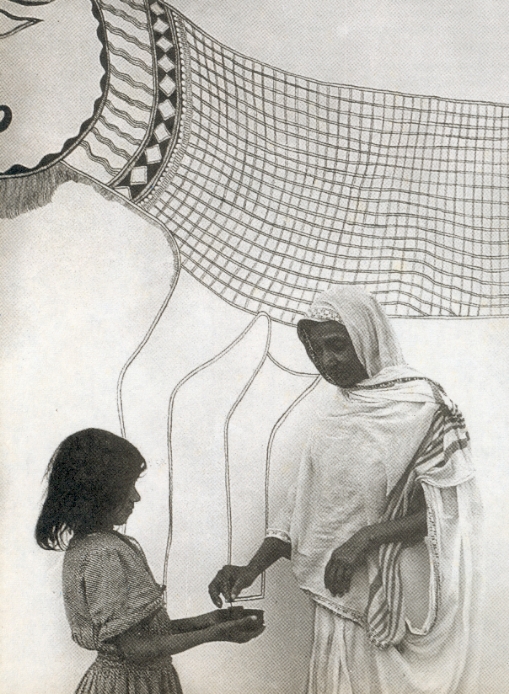
Sita Devi, wall painting, Delhi seventy-eighty (please if you know the photographer's name send me a message)
The legendary figure of Madhubani painting, Sita Devi, died in Madhubani yesterday. She was 92. Sita Devi was the first to bring the intricate Bharni style of Madhubani painting out of village homes and into urban drawing rooms which had fetched her the Padma Shri in 1981. She was honoured for the first time with a state award in 1969 and the national award in 1975. She was also conferred with Bihar Ratna Samman in 1984.
Born in 1914, Sita Devi’s fans included the first President, Dr Rajendra Prasad, Lal Bahadur Shastri, Indira Gandhi, Babu Jagjivan Ram and Lalit Narayan Mishra. According to here eldest son, Ram Dev, she was regarded as mother at Jitwarpur village for her social commitment. She had encouraged about 1,000 others in the village to learn the art of Madhubani painting. According to noted intellectual, N.K. Jha, against many underdeveloped villages in the state, Jitwarpur stands as an exception — courtesy Sita Devi. The approach road to the village is paved with bricks. Even roads inside the village are metalled. It was because of Sita Devi that the village first had a primary school, which was later converted into a secondary one. Ram Dev said her mother used to stay at Pragati Maidan in New Delhi and was determined to pursue issues concerning the development of the village. “Many top political leaders used to come to my mother to see the paintings and every time she would take up some issue concerning the development of the village”, he said.
Suraj Prasad of Patna,who stays near Jitwarpur, said whatever development in and around Jitwapur area had experienced in the past, all the credit should go to Sita Devi. Ram Dev, said his mother’s dream before death was that Jitwarpur should continue to promote Madhubani paintings.
The Tribune Thursday, December 15, 2005, Chandigarh, India
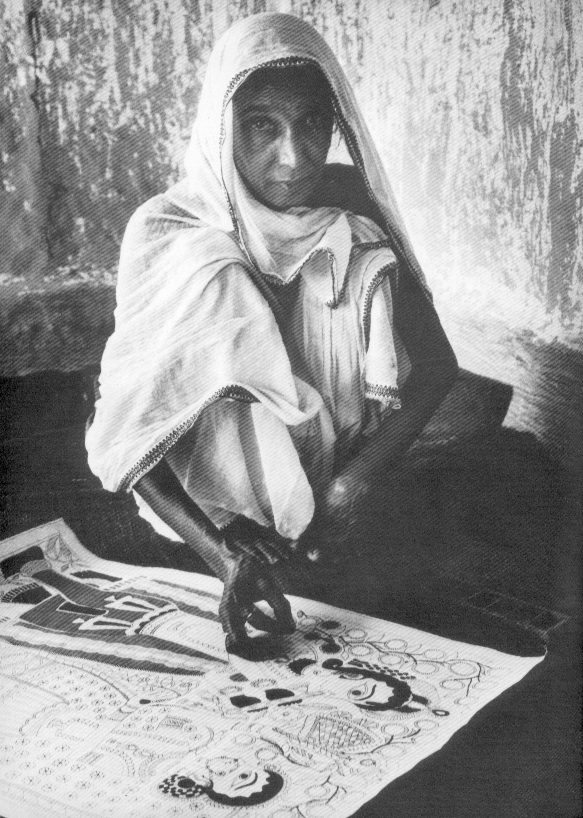
Sita Devi, photo Edouard Boubat, 1970, in L'art du Mithila by Yves Véquaud
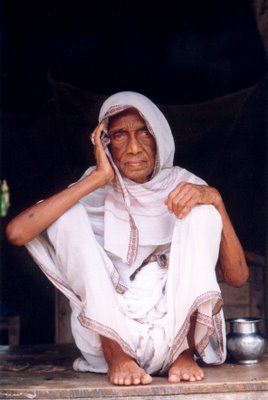

Sita Devi, photos Hervé Perdriolle, Jitwapur 1999
Photos toujours aussi troublantes, Sita Devi, chez elle, dans le Mithila, ancien royaume du nord de l’Inde, à la frontière du Népal, au pied de la chaîne de l’Himalaya. Sita Devi, grande dame du Mithila painting. Légende vivante décédée en 2005. Troubles, plus de vingt années séparent mes propres photos de celles faites par Edouard Boubat, et Sita Devi semble toujours la même, comme éternelle, immuable. Toujours la même pose, on pourrait croire le même sari. La même façon de s’en parer, au geste près. Troubles, la même attitude, la même expression perdue, comme dans le vague, lointaine et pourtant si présente, de cette présence née de l’absence. Trouble, la cataracte, les yeux vitreux pourtant toujours expressifs. La vue de Sita Devi ne lui permettait plus de dessiner lorsque je la rencontrais et la photographiais à la fin des années 1990. Trouble, l’attitude, lovée sur elle-même, entre le fœtus et la momie. Yves Véquaud, rencontré à Paris après mes premiers voyages dans le Mithila, me parle de Sita Devi avec un respect et une rare admiration. Début du troisième millénaire, je revois pour la dernière fois Yves Véquaud. Je lui demande comment il vit, quelles sont ses occupations, il me répond que sa mère est malade (elle habite un appartement située dans le même immeuble) et que, comme le ferait un fils en Inde, il s’occupe d’elle. Il me dit être retourné récemment en Inde, après plus de dix années d’absence. Avec émotion il me raconte sa visite à Sita Devi, me décrit le mot qu’il a inscrit dans son livre d’or. Il y parle de ses autres mères, Sita Devi, sa seconde mère, Sita Devi comme incarnation de l’Inde, mère patrie, mère par essence et nature.
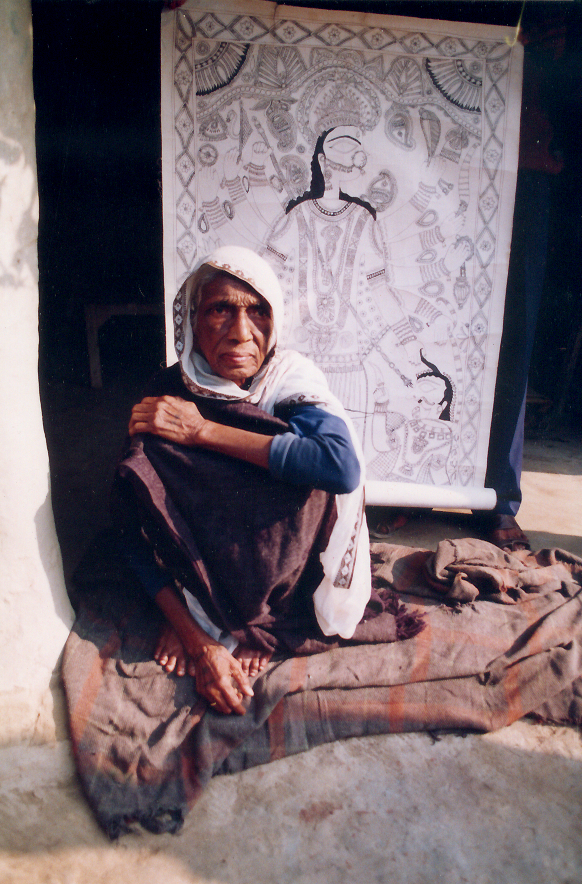
Sita Devi, photo Hervé Perdriolle, Jitwapur 1997

Sita Devi, photo Hervé Perdriolle, Jitwapur 1997

Sita Devi, photo Hervé Perdriolle, Jitwapur 1997
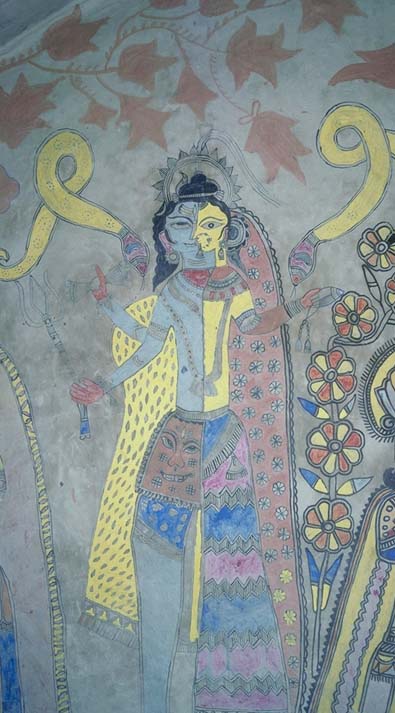
This Sita is the true 'Devi' of Jitwarpur (Madhubani, Bihar)
Radhika D Srivastava(9 Nov, The Times of India)
Sita Devi's hands are not able to recreate the magic that won her the Padma Shri in the 1960s. However, she doesn't need to. At 95, she is a living legend and stories about her interaction with prime ministers and presidents of yesteryear is part of the local lore. It is Sita Devi's fame that has given her village the development it needed. Jitwarpur falls under Madhubani Assembly segment in Madhubani district. The surrounding villages, barring a few that have had other famous Madhubani artists, are like the rest of Bihar decrepit, awaiting for someone to come and wave the magic wand and change people's lives. Sita Devi has worked tirelessly for half-a-century, etching out faces and figures on paper. Today Jitwarpur residents revere her not for the Padma Shri she won but for the progress she brought to her village."We do not need a politician. What Sita Ma has done for us, no politician ever will," remarked Jagdev Jha, a tea stall owner in Jitwarpur. Election here is less than 10 days away but there are no sign of it anywhere. Customers sipping tea outside Jha's shop do not talk about politics. Mention politicians, and wry smiles appear on their face. "We have no demands. We have got whatever we wanted," said Soorji, a helper in the village temple. "Ours is among the few villages in the entire district that has a government school. The approach road to the village is paved with bricks. Even roads inside the village are metalled," he added. Sitting outside her brick house with a warm shawl around her frail shoulders, Devi shakes her head when elections are mentioned. "Politicians do nothing," she says, her voice no more than a whisper."I lived in Pragati Maidan in New Delhi and knew big shots. I always spoke to them about my village and how things could improve here," she said. Unlettered herself, Devi asked the Centre to construct a primary school. It was done. Later, when children passed standard V and did not have secondary school in the vicinity, Devi again made a demand. And within a year, Jitwarpur had a secondary school. When each house took to painting and work needed to go on after sunset, Sita Devi approached the authorities with another request. And soon electricity poles were erected in the village and power flowed into every household. Nobody could say no to Ma. "She is among the very few who has visited 10 countries showcasing Madhubani paintings," said Ram Dev, her eldest son.Devi is considered a living legend. She was the first to bring the intricate art of Madhubani painting out of village homes and usher it into urban drawing rooms. And after her paintings began to sell, about 1,000 others in her villagers took to learning this art. Said Sita Devi: "I learnt it from my mother. We used to paint on the mud walls of our homes on festivals. But after some outsiders saw and appreciated it, we tried it on paper." Breaking tradition, Sita Devi's youngest son chose to learn the art from his mother. Said Dev, "Although men are not known to paint, my brother learnt it well. Among the thousands my mother taught, he is among the best." Talking about her village, Sita Devi says: "I hope Jitwarpur will continue to have celebrities who will keep things going here. It is an affirmation of the people's belief that artists, not politicians, will continue to bring progress to the area."
Oeuvres de Sita Devi dans les collections du Musée du Quai Branly, Paris, France
Works of Sita Devi in the Musée du Quai Branly Collections, Paris, France
If you have informations about Sita Devi (biography, bibliography, photos, films or videos, etc.) please contact me : Herve Perdriolle